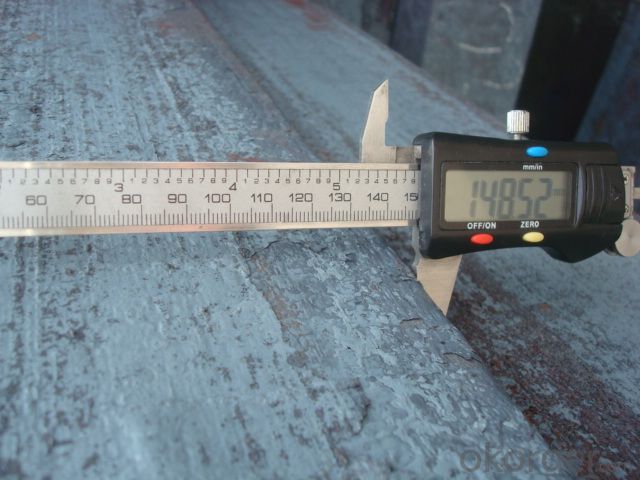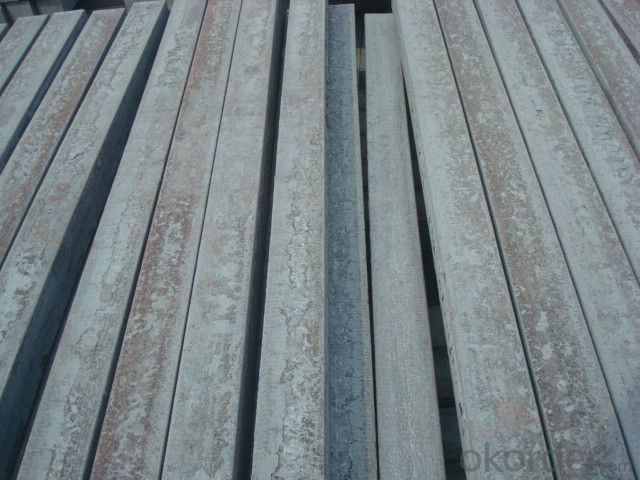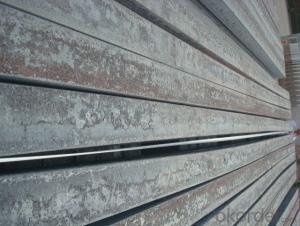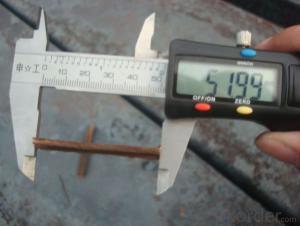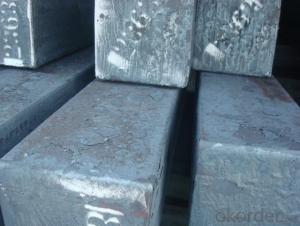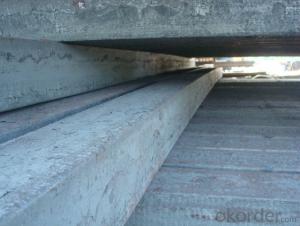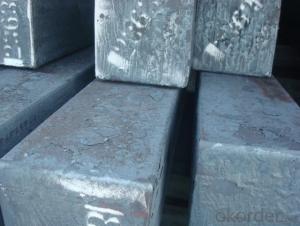Alloyed Continue Casting Steel Billet by Blast Furnace Manufactured by Big Steel Mill
- Loading Port:
- Tianjin
- Payment Terms:
- TT OR LC
- Min Order Qty:
- 1000 m.t.
- Supply Capability:
- 100000 m.t./month
OKorder Service Pledge
OKorder Financial Service
You Might Also Like
Alloyed Continue Casting Steel Billet by Blast Furnace Manufactured by Big Steel Mill
1.Structure of Alloyed Continue Casting Steel Billet by Blast Furnace Manufactured by Big Steel Mill
Alloyed Continue Casting Steel Billet by Blast Furnace According to the Standard of YB2011-83 is the raw material of all kinds of steel mill. Billet section of square, round, flat, rectangular and abnormity, etc Several, mainly related to shape of rolled products. Simple rolled section steel, choose cross section of square billet or rectangular billet. rolling The sector products such as flat steel, Angle steel, select the rectangular billet or slab. Had better profiled billet when production beams, channels, and in rolling process Lines and improve the yield. The raw material of round billet is the production of seamless tube.
2.Main Features of Alloyed Continue Casting Steel Billet by Blast Furnace Manufactured by Big Steel Mill
Steel Bloom Manufactured by Blast Furnace section size should meet the requirements of rolling deformation and finished product quality, but also roll strength and biting condition of restrictions. General steel Billet section height H. And the roll diameter D The ratio of the ( namely H/D) Should be less than or equal to zero 0.5 . Length of steel billet by finishing temperature, Rolling time and the length of the product Or times ruler. When heated too long accident prone to bump the furnace wall of steel, too short, furnace bottom utilization rate is not high, influence the heating furnace production. For the production Choose a variety of steel and steel billet, should consider the affinities of billet, as far as possible in order to improve the productivity of the roughing mill, simplify the stock management of workshop.
3. Alloyed Continue Casting Steel Billet by Blast Furnace Manufactured by Big Steel Mill Images
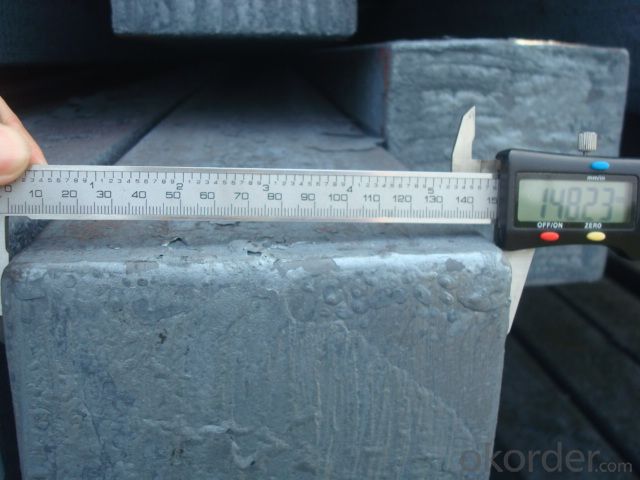
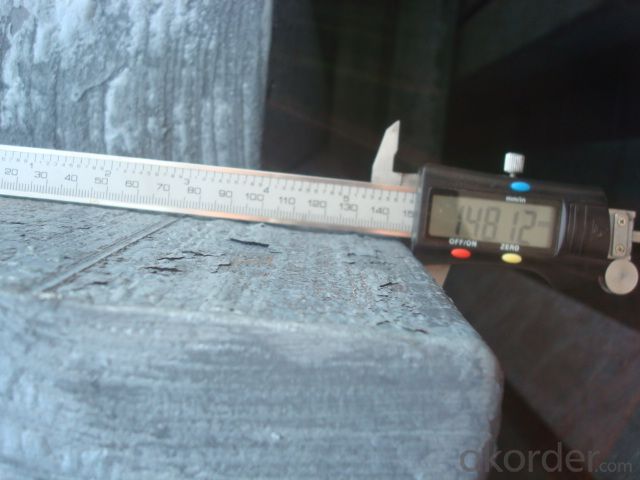
4. Alloyed Continue Casting Steel Billet by Blast Furnace Manufactured by Big Steel Mill Specification
Steel Bloom Manufactured by Blast Furnace rolled steel, after processing can be used for mechanical parts, forging parts, processing all kinds of steel, steel Q345B channel steel, wire rod is the role of the billet. Steel billet is used in the production of semi-finished products, generally cannot be used directly for the society. Steel billets and steel are strictly divided into standard, cannot decide to whether the business enterprise of the final product, and according to unified standards to perform the whole society. Typically, billet and the steel is relatively easy to distinguish, but for some steel billet, and have the same specification and same steel purposes (such as rolling tube billet), whether can be used for other industries, whether through steel processing process, whether through a finished product rolling mill processing to distinguish
Material standard The editor Range of thickness: 150-240 - mm + / - 5 mm width range: 880-1530 - mm + / - 20 mm Length: 3700-10000 - mm + / - 500 - mm Cross-sectional size: 64 * 64; 82 * 82; 98 * 98; 124 * 124; 120 * 150; 152 * 164; 152 * 170 mm Length: 9000 mm Section of tolerance: billet: 1.0 + / - 2.0-1.0 + / - 1.0 mm slab: width: + / - 2.0 mm thickness: + / - 3.0 mm The length tolerance: + / - 200 mm Section diagonal tolerance: 3.5-8.0 MM Billet section size protrusions requirements: < 1242 mm, do not allow; > = 1242 mm, < = 2 mm 1242 mm, < = 3 mm Beheading (shear) extension deformation: < 1242 mm billet: no control; The slab: < = 15 mm Surface tilt: no more than billet section 0.1 Bending: every 1 m length is not more than 10 mm The distortion: length < = 5 m, < = 11. ; The length of the < = 7.5 M, < = 5. Material % 3 sp/PS chemical composition: C Mn Si S P
5.FAQ of Alloyed Continue Casting Steel Billet by Blast Furnace Manufactured by Big Steel Mill
We have organized several common questions for our clients,may help you sincerely:
①How to check every lot of cargo?
Casting billet by batch acceptance, each batch is composed of the same brand, the same cross section size.
②What requirement according to the standard on the size?
Height is greater than the
3 mm
Scratches, indentation, scratch, pores, wrinkles, cold splash, handle, bump, pits
And depth is greater than the
2 mm
The hairline.Casting billet cross-section can not have shrinkage cavity, subcutaneous bubble.
Crack in continuous casting billet surface shall not be visible to the naked eye, overlapping, skull patch, or scarring, inclusion and depth
Height is greater than the
3 mm
Scratches, indentation, scratch, pores, wrinkles, cold splash, handle, bump, pits
And depth is greater than the
2 mm
The hairline.Casting billet cross-section can not have shrinkage cavity, subcutaneous bubble.
③How to check the appearance?
Appearance standard 2.1And the difference between the lengths of the continuous casting billet in cross section of diagonal should conform to the table2The provisions of the. 2.2And the degree of curvature of continuous casting billet per meter shall not be greater than20 mm,The total bending shall not be greater than the total length2%. 2.3, casting billet are allowed drum belly, but height shall not exceed the casting billet length allowed is deviation. 2.4Oblique cutting, casting billet end shall not be greater than20 mm. 2.5Casting billet end caused by shear deformation, spread shall not be greater than the length10%. 2.6, casting billet can not have apparent reverse..
- Q: What are the different methods of steel billet cooling?
- There are several different methods of steel billet cooling that are commonly used in the steel industry. These methods include air cooling, water cooling, and controlled cooling processes. One method of cooling steel billets is through air cooling. This involves allowing the billets to cool naturally in ambient air, without any additional cooling mechanisms. Air cooling is a simple and cost-effective method, but it may result in slower cooling rates and less controlled cooling conditions compared to other methods. Water cooling is another common method used to cool steel billets. This involves immersing the billets in water or spraying them with water to accelerate the cooling process. Water cooling provides more efficient and controlled cooling rates compared to air cooling. It allows for faster cooling and can help achieve desired material properties, such as increased hardness or improved microstructure. Controlled cooling processes are a more advanced method used to cool steel billets. These processes involve precise control of temperature and cooling rates to achieve specific material properties. One such process is known as quenching, which involves rapid cooling of the billets in a controlled medium, such as oil or water, to achieve a desired hardness. Another controlled cooling process is known as annealing, which involves slowly cooling the billets to relieve internal stresses and improve their machinability. In addition to these methods, there are also specialized cooling techniques, such as spray cooling and water mist cooling, that are used in specific applications or industries. These methods involve spraying a fine mist of water onto the billets to achieve rapid and uniform cooling. Overall, the choice of cooling method depends on various factors, such as the desired material properties, production requirements, and cost considerations. Different cooling methods offer different benefits and trade-offs, and it is important for steel manufacturers to select the most suitable method for their specific needs.
- Q: What are the major steel billet producing countries?
- The major steel billet producing countries are China, India, Russia, Japan, and the United States. China is by far the largest producer of steel billets, accounting for over half of the global production. This is due to the country's massive steel industry, which has experienced significant growth in recent decades. India is the second-largest producer, with a rapidly expanding steel sector as well. Russia is known for its strong steel industry and is the third-largest producer. Japan, although its steel production has declined in recent years, still remains a significant player in the steel billet market. Lastly, the United States is a major producer of steel billets, with a focus on high-quality specialty steel products. These countries play a crucial role in meeting the global demand for steel billets, which are essential raw materials for various industries, including construction, automotive, and infrastructure.
- Q: What are the safety measures involved in handling steel billets?
- Some safety measures involved in handling steel billets include wearing personal protective equipment such as gloves, safety glasses, and steel-toed boots to protect against potential injuries. Additionally, using proper lifting techniques and equipment like cranes or forklifts can help prevent strain or accidents. It is important to ensure that the work area is well-lit and free of clutter to minimize trips and falls. Regular maintenance and inspection of equipment is also crucial to prevent any malfunctions or hazards.
- Q: What are the different types of shearing machines used for steel billets?
- There are several types of shearing machines commonly used for cutting steel billets. These machines are designed to provide precise and efficient cutting operations in the steel industry. Here are some of the different types of shearing machines used for steel billets: 1. Guillotine Shears: Guillotine shears are one of the most widely used shearing machines for cutting steel billets. They feature a stationary bed and a moving blade that moves vertically to cut through the material. Guillotine shears offer high cutting accuracy and are capable of cutting thick billets with ease. 2. Flying Shears: Flying shears, also known as rotary shears, are another popular type of shearing machine used for cutting steel billets. These machines have a rotating circular blade that cuts through the billet as it moves along the conveyor. Flying shears are known for their high cutting speed and can handle large volumes of billets. 3. Cold Shears: Cold shears are specifically designed for cutting steel billets at lower temperatures to prevent any heat damage to the material. These shearing machines use a hydraulic or mechanical system to apply force and cut through the billet. Cold shears are commonly used in industries where the steel billets need to be cooled down before further processing. 4. Rotary Shears: Rotary shears are typically used for cutting steel billets into smaller sections. These machines feature multiple blades mounted on a rotating drum, which cuts the billet into desired lengths. Rotary shears offer high cutting efficiency and are often used in industries where small-sized billets are required. 5. Hydraulic Shears: Hydraulic shears are versatile shearing machines that can be used for cutting various materials, including steel billets. These machines use hydraulic power to provide the necessary force for cutting through the billet. Hydraulic shears offer high cutting speed and can handle large-sized billets efficiently. Each type of shearing machine mentioned above has its own advantages and is suitable for specific applications in the steel industry. The choice of shearing machine depends on factors such as the size and thickness of the billet, required cutting accuracy, production volume, and other specific requirements of the steel processing operation.
- Q: What are the main challenges in steel billet production?
- Some of the main challenges in steel billet production include maintaining consistent quality, optimizing production processes to minimize energy consumption and waste, ensuring proper inventory management to meet customer demand, and dealing with fluctuations in raw material prices. Additionally, meeting environmental regulations and addressing safety concerns are also significant challenges in steel billet production.
- Q: What are the different welding techniques used for steel billets?
- Some of the different welding techniques used for steel billets include shielded metal arc welding (SMAW), gas metal arc welding (GMAW), flux-cored arc welding (FCAW), submerged arc welding (SAW), and laser welding. Each technique has its own advantages and is chosen based on factors such as the thickness of the billet, desired weld quality, and production requirements.
- Q: What are the main applications of steel billets in the aerospace industry?
- Steel billets possess exceptional strength, durability, and thermal properties, making them an indispensable component in the aerospace industry. Their numerous applications include the production of aircraft structural components, engine parts, fasteners and connectors, as well as hydraulic and pneumatic systems. A primary application of steel billets in the aerospace industry is seen in the manufacturing of aircraft structural components. These billets are commonly utilized to produce critical parts such as landing gear, wing spars, fuselage frames, and engine mounts. These components provide the necessary strength and stability required for safe and efficient flight. Furthermore, steel billets find use in the aerospace industry for the production of engine components. Their high heat resistance and ability to withstand extreme temperatures make them ideal for manufacturing turbine blades, shafts, and other critical parts within jet engines. These components must endure intense heat and pressure, and steel billets offer the required properties for reliable and efficient engine performance. Additionally, steel billets play a vital role in the aerospace industry by being applied in the production of fasteners and connectors. These components are crucial for securely joining various parts of an aircraft, ensuring structural integrity and safety during flight. Steel billets are employed to manufacture high-strength bolts, screws, and other fasteners, providing the necessary strength and reliability for aerospace applications. Moreover, steel billets are frequently used in the aerospace industry for the manufacture of hydraulic and pneumatic systems. These systems are responsible for controlling the movement of the aircraft, landing gear operation, and other critical functions. Steel billets are utilized to produce hydraulic cylinders, valves, and tubes, offering the required strength and resistance to withstand high pressures and extreme conditions. In conclusion, the aerospace industry heavily relies on steel billets for various applications, including aircraft structural components, engine parts, fasteners and connectors, as well as hydraulic and pneumatic systems. The exceptional strength, durability, and thermal properties of steel billets ensure the safety, efficiency, and reliability of aerospace operations.
- Q: How are steel billets used in the manufacturing of construction machinery?
- The manufacturing of construction machinery relies heavily on steel billets. These billets, which are semi-finished steel products, play a vital role in the industry as they serve as the primary raw material. The production of steel billets involves a process called continuous casting, in which molten steel is poured into a mold to form solid billets. Once the steel billets are ready, they undergo a series of manufacturing processes to shape them into the desired components for construction machinery. These processes include forging, rolling, and machining. Forging requires heating the billets to high temperatures and using pressure to shape them into various parts such as gears, shafts, and axles. Rolling, on the other hand, is a commonly used method in which the billets are passed through rolling mills to reduce their size and give them specific forms such as plates, bars, or sheets. These rolled billets can then be further processed to create components like chassis, frames, or structural beams for construction machinery. In addition to forging and rolling, machining processes are employed to shape the steel billets into intricate parts with precise dimensions. This involves using cutting tools to remove excess material and create specific shapes and features like holes, threads, or grooves. Machining is crucial in producing components such as engine parts, hydraulic cylinders, or gearboxes for construction machinery. Overall, steel billets serve as the initial stage in the manufacturing process of construction machinery. They provide the necessary raw material that undergoes various processes to become the required components. The strength, durability, and versatility of steel make it an ideal material for construction machinery, ensuring that the final product can withstand heavy loads, harsh environments, and demanding applications.
- Q: How are steel billets used in the construction industry?
- The construction industry relies heavily on steel billets, which are essential for supporting and enhancing the structural integrity of buildings and infrastructure. These semi-finished steel products are heated and shaped to meet the specific requirements of construction projects. One important use of steel billets is in the production of rebar, which provides strength and stability to concrete structures. By heating and rolling the billets into long, cylindrical shapes, reinforcement bars are created. These bars are embedded within the concrete, increasing its tensile strength and preventing cracks or structural failure. Steel billets are also used to manufacture structural steel sections, including beams, columns, and channels. These sections are crucial for constructing the framework of a building and providing support and load-bearing capacity. Depending on the project's specifications, steel billets are heated and rolled into various shapes and sizes. These sections are then assembled to ensure the stability and durability of the building. In addition to rebar and structural steel sections, steel billets are utilized in the production of other construction components. This includes steel plates, pipes, tubes, and wires, which serve different purposes in the construction industry. Steel plates reinforce building foundations, while steel pipes and tubes are used for plumbing, drainage, and HVAC systems. Steel wires strengthen concrete structures and act as reinforcement in precast concrete elements. Overall, steel billets are crucial in the construction industry as they provide the necessary raw material for producing reinforcing bars, structural steel sections, and other construction components. Their strength and versatility make them essential for ensuring the safety, stability, and longevity of buildings and infrastructure projects.
- Q: How are steel billets used in the manufacturing of marine components?
- Due to their strength, durability, and versatility, steel billets are indispensable raw materials utilized in the production of marine components. Essentially, steel billets are semi-finished steel products that are cast into specific shapes, typically squares or rectangles, via continuous casting. These billets serve as the initial stage for a variety of marine components. Hot rolling is a primary method employed in the manufacturing of marine components using steel billets. In this process, the steel billet is heated to high temperatures and then passed through a series of rollers to shape it into the desired form. This can involve transforming the billet into rods, bars, beams, or other structural shapes commonly utilized in marine applications. Forging is another technique employed in the manufacturing of marine components using steel billets. This process involves heating the billet to high temperatures and subsequently applying pressure to shape it into the desired form. Forging is commonly employed to manufacture marine components such as propeller shafts, crankshafts, and other high-strength parts that necessitate precise shaping and exceptional mechanical properties. Furthermore, steel billets can be utilized in the manufacturing of marine components through the process of machining. Machining entails the removal of material from the billet using various cutting tools to create intricate shapes and features. This method is commonly employed to produce marine components such as valves, fittings, and other precision parts that require meticulous tolerances and intricate designs. In conclusion, steel billets play a pivotal role in the manufacturing of marine components. Their strength, durability, and versatility make them an ideal raw material for producing various marine parts through processes such as hot rolling, forging, and machining. By utilizing steel billets, manufacturers can ensure that the marine components they produce are capable of withstanding the harsh conditions and demanding requirements of the marine environment.
Send your message to us
Alloyed Continue Casting Steel Billet by Blast Furnace Manufactured by Big Steel Mill
- Loading Port:
- Tianjin
- Payment Terms:
- TT OR LC
- Min Order Qty:
- 1000 m.t.
- Supply Capability:
- 100000 m.t./month
OKorder Service Pledge
OKorder Financial Service
Similar products
Hot products
Hot Searches
Related keywords


